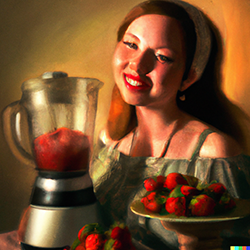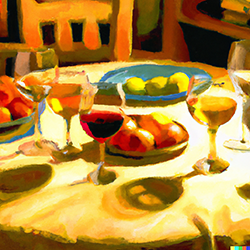Struggling with Fruit Wines from Fresh Fruit?
Posted by Matteo Lahm on 16th Jan 2023
If you are making fruit wines from fresh fruit, hats off to you! They are more difficult than wines made from grapes with a much larger margin of error. Grapes are the closest thing to being readymade from nature for winemaking. High quality grapes grown in California might not require any sugar or acidity adjustments at all. They come right off the vine with the right chemistry for your yeast to happily ferment them into wine. Grapes from the North East and other regions that are not optimal for viticulture are often low in sugar, acid or both. Still, with grapes, it is usually minor tweaks by comparison. Other fruits require much more manipulation. Even in the best case scenario, they are lacking in either the juice to pulp ratio, sugar, acidity or all of the above. For this reason, the overwhelming majority of commercial wines are made from wine grapes. That is not to say great wines from other fruits are not possible, you just need to know what you are up against.
Fruits other than grapes are bred to be eaten. Wine grapes are cultivated to make wine. Vintners carefully wait until grapes reach optimum sugar and acidity levels. They then harvest them and immediately begin the winemaking process. Table fruits are often harvested early. They ripen on their way to the grocery store, so they are ready to eat when you buy them and don’t start prematurely rotting. As you well know, every week’s pickings taste different. Some are tart, others flat and the sugars can vary greatly.

Despite this, you must have encountered fixed recipes for various fruit wines at one point, or another. You might even be using some of them. If so, do these recipes discuss maceration techniques or get into the specifics of pH and sugar adjustments? If they are just tell you to mix a bunch of ingredients without explaining how to prepare and test your fruit, they are incomplete. This might explain why you might have had spoilage, stuck fermentation or wine that was too alcoholic and lacking in flavor. It could also explain sulfur smells at the end of fermentation. If there is too much sugar, your yeast will struggle. Even the most formidable wine yeasts cannot ferment beyond 18% ABV. But, they will try. When they do, they get stressed and produce hydrogen sulfide. If you have ever smelled it, you know how dreadful it is.
A little technical knowledge and procedure can save your wine from all these issues. They can also save you money. First let’s compare the wine grape to other fruits commonly used for fruit wines so you get a better idea of their profiles. Wine grapes mostly range from 20-26 brix (sugars.) Tartaric is the dominant acid with a pH between 3.2 and 3.8. Wine grapes can get as high as 4.0 but will not produce good wine. In fact, any grape with a pH above 3.5 cannot be protected by sulfites. Consider that 3.4 pH is ten times more acidic than 3.6.
So now, let’s take a look at basic profiles of other fruits.
Blueberries:
pH range 3.3-3.9
Brix (sugar): 16-20
Dominant Acids: Malic and Citric Acid
Blackberries:
pH range 3.2-3.5
Brix (sugar): 8-14
Dominant Acid: Malic Acid
Oranges:
pH range 3.1-4.1
Brix (sugar): 11-15
Dominant Acid: Citric Acid
Strawberries:
pH range 3.0-3.7
Brix (sugar): 8-12
Dominant Acid: Malic Acid
Apples:
pH range 3.3-3.9
Brix (sugar): 13-17
Dominant Acid: Malic Acid
Bananas:
pH range 4.5-5.2
Brix (sugar): 14-18
Dominant Acid: Citric Acid
Raspberries:
pH range: 3.0-4.0
Brix (sugar): 8-10
Dominant Acids: Citric and Malic Acid
You might have noticed the blueberry and to a lesser degree, the blackberry can get pretty close to the wine grape in pH and sugar. Just like grapes, they are berries. This explains their popularity for wine, but in most cases, you will need to add sugar, especially with blackberries. Some can have 1/3 the amount of wine grapes. Low sugar means low ABV. Despite their similarity, your recipe for blueberry or blackberry wine might also call for additional water. Making either without water can be cost prohibitive. Grapes simply have a higher juice to weight ratio.
Once you get out of the berry family, most, if not all fruit wine recipes require adding water. Think about how much that raises your pH. To add insult to injury, the optimal pH range for wine yeast is 3.2-3.5. Once you get beyond 4.0, you might get stuck fermentation and even if you don’t, bacteria might set up shop before it's even done. Adding water without acid manipulation is a recipe for disaster, pardon the pun.

Regardless of whether your recipe calls for water, the first thing you should do before adding anything is pulverize your fruit to the max. You want to release as much fruit juice as possible so you can do a baseline test for acids and sugars. If you have to add water, this will give you a solution that is liquid enough to get readings. Believe it or not, food processors and blenders can assist you. Of course, you want to buy a separate one just for your wines. The last thing you need is some dominant bread yeast messing up your batch from the cookie dough you mixed the previous week. You may need to add some water during the blending process especially with fruits like apples or bananas. You should only add enough to make the solution adequately liquid at this stage. It is better to initially test when it is more concentrated. Adding water is easy. Removing it is not. Pour everything into your fermenter through a muslin bag. Tie off the bag and add it as well. Then you can add additional water as needed.
Some recipes recommend boiling however, this is not advisable nor necessary. Heat is not a good thing because it is like pasteurization. Cooked fruit loses a lot of the characteristics you want to preserve. You can just warm it enough to assist with dissolving sugars. Once you have added the water, stir it really well, add pectic enzyme and sulfites. Pectic enzyme is very useful. It will help you extract a lot more color and flavor. It expedites the breakdown of the fruit matter. When it has cooled to room temperature, squeeze out the muslin bag, stir it well and take more pH and sugar measurements.
You can use test strips for pH readings or if you want to make an investment, get a pH meter. Test strips are cheap but if you are working with fruits with dark pigments, they can be difficult to read because of staining. In the end, a pH meter is the most reliable way to test the acidity of your juice.
Once you get a good reading, you can then proceed to add your acid blend. Be suspicious of any recipe that gives a fixed amount. Considering that one batch of raspberries can have ten times the acidity of another. Add too large of a large dose to an already tart fruit and your wine will be sour. This is why you test. Add your acid blend incrementally at rate of 0.2-0.5 grams of acid per liter. If your pH is really high, you can start with 0.5 grams per liter and then start bracketing down as you get closer to your target. You should shoot for that 3.2-3.5 range depending on your taste. If you like your wine tarter, go towards the lower end. Also, if you really want to get scientific, you might want to research the acid profiles of your fruit and mimic them with the acids you add. The short list above tells you the dominant acids but you might even want to make your own blend that follows the broader acid profile. Individual fruit acids are readily available and inexpensive. When adding acid blend, dissolve each dose in a little warm water. This will help it mix in more quickly allowing you to take faster readings.

After your acids are tuned, you can tweak your sugar. The same skepticism should apply to recipes that call for a set amount. After reading this, you have probably asked yourself how arbitrarily adding a predetermined amount of sugar could make sense, considering how much sugars can also vary. Take your readings and then based on your alcohol preferences, add your sugars to the desired amount. Use the same technique of dissolving them in small amounts of warm water.
If you add sulfites, you won’t pitch your yeast until the next day. Your juice will have had a whole day for more sugars and acid to dissolve. Therefore, for your first additions, stay on the low side. Your readings might change the following day which will really allow you to pinpoint exactly what you want. Like water, it is easy to add acid and sugar but difficult to remove them.
If you follow these simple procedures, you will get much more consistent wine and smoother fermentation. The only other suggestion to consider is adding fruit flavorings when you're bottling. All natural fruit flavorings contain all the stuff that you want. They make blueberries taste like blueberries and as Mr. Willy Wonka says, the snozberries taste like snozberries. They are extracts of terpenes and pigments that enhance flavor, color, smell and mouthfeel. And guess what, commercial fruit wine producers use them too.
From that point, you can follow all the standard winemaking processes. Squeeze out your muslin bag at least once a day during primary and right before you transfer to secondary. Rack your wine multiple times or filter to remove sediment. Add Potassium Sorbate before back sweetening and bottle.
There you have it. Not saying you should toss your recipes. Just don’t follow them to the letter. You must know what is in your fruit before you start manipulating it. There are simply too many variables to guess. Give your yeast the right fermentation environment with enough acidity to make your wine refreshing and nuanced. You will get a nice balance to your ABV levels and have enough tartness to counterbalance back sweetening. Good luck!

